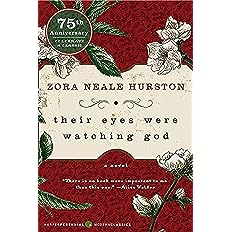
Eighty-seven years after its publication, this book almost disappeared from the American public until it was finally appreciated and republished, becoming one of the enduring books of the twentieth century. The author’s fame reached its zenith in 1943 with a Saturday Review cover story. And yet seven years later, she would be serving as a maid in Rivo Alto, Florida, and ten years later, die in the St. Lucie County Welfare Home of “hypertensive heart disease.” She’d been buried in an unmarked grave in the segregated cemetery, Garden of Heavenly Rest, in Fort Pierce, Florida.
Some consider this book a “protofeminist postcard from Haiti” as the author moved to Haiti, which released a flood of emotions that forced her to sit down for seven weeks and write what is considered one of the most widely read and highly regarded novels in the entire canon of African American literature.
Published in 1937, this is the story of Janie Crawford, a deep-thinking, deep-feeling black woman who embarks on a search for her identity. Her journey begins at sixteen when her dying grandmother marries her off to Logan Killicks, an older man with sixty acres, a mule, and a “lump of fatback on his neck that Janie despises.” Rebelling against her husband’s attempts to turn her into a workhorse, she runs off with Joe Starks, a citified fellow with big dreams and an even bigger voice. He married Janie and took her to Eatonville, where he became mayor, postmaster, and primary landowner. After his death, she falls in love with Tea Cake, a free-spirited laborer much younger than herself.
Among the many challenges facing Janie and Tea Cake is a devastating hurricane similar to the one in 1928 at Lake Okeechobee, which killed two thousand people in the Florida Everglades.
One challenge for those not from the South is the author’s use of the vernacular, which was a fundamental framework of all but one of her novels. Here’s one comment about the challenges facing Janie’s first husband, Joe Starks:
“It’s uh sin and uh shame runnin’ that po’ man way from here lak dat. Colored folks oughtn’t tuh be so hard on one ‘nother.’”
I could understand most of it because I learned Krio, an official language in Sierra Leone. However, it resembles Creole, which develops by simplifying and mixing different languages into a new form. For most readers, this style makes “speed reading” inadvisable.
The author freely uses incidents from her own life, but unlike her, Janie seeks her identity in the eyes and arms of men. On the other hand, Hurston sought her identity in her world, in her work, speech, writing, and mind. Given these protofeminist themes, some male critics did not receive the book well. Richard Wright, the best-selling author of Native Son, dismissed her book: “The sensory sweep of her novel carries no theme, no message, no thought.”
The author’s influence on the lives of writers and members of the Black community is difficult to measure. Tiya Miles, the National Book Award-winning historian, said, “When I found Zora Neale Hurston’s Their Eyes Were Watching God, on the self of my high school library at around age 15, I felt embraced and disturbed by it. It was, and is, a pivotal work of Black environmental writing…”
“Their Eyes Were Watching God belongs in the same category with [the works of] William Faulkner, F. Scott Fitzgerald, and Ernest Hemingway, that of enduring American literature.”-Saturday Review
“A deeply soulful novel that comprehends love and cruelty, and separates the big people from the small of heart, without ever losing sympathy for those unfortunates who don’t know how to live properly.” —Zadie Smith
About the Author
Zora Neale Hurston was a novelist, folklorist, and anthropologist. She wrote four novels (Jonah’s Gourd Vine, 1934; Their Eyes Were Watching God, 1937; Moses, Man of the Mountains, 1939; and Seraph on the Suwanee, 1948); two books of folklore (Mules and Men, 1935, and Every Tongue Got to Confess, 2001); a work of anthropological research, (Tell My Horse, 1938); an autobiography (Dust Tracks on a Road, 1942); an international bestselling nonfiction work (Barracoon: The Story of the Last “Black Cargo,” 2018); and over fifty short stories, essays, and plays. She attended Howard University, Barnard College, and Columbia University and was a graduate of Barnard College in 1928. She was born on January 7, 1891, in Notasulga, Alabama, and grew up in Eatonville, Florida.
Product Details
- Publisher : Amistad; 75th Anniversary edition (May 30, 2006)
- Language : English
- Paperback : 219 pages
- ISBN-10 : 0061120065
- ISBN-13 : 978-0061120060
- Reading age : 16+ years, from customers
- Lexile measure : 890L
- Item Weight : 31 pounds
- Dimensions : 1 x 5.5 x 0.8 inches
About the Reviewer
Mark Walker was a Peace Corps Volunteer in Guatemala and spent over forty years helping disadvantaged people in the developing world with agencies like Food for the Hungry, Make A Wish International, and Hagar USA. His book, Different Latitudes: My Life in the Peace Corps and Beyond, was recognized by the Arizona Literary Association. His second book, My Saddest Pleasures: 50 Years on the Road, won the 2023 Peace Corps Writers’ Award for Best Travel Book. He’s a contributing writer for Literary Traveler, Wanderlust Journal, and The Authors’ Show. “The Million Mile Walker Review: What We’re Reading And Why” can be found in the Arizona Authors’ Association Newsletter, Authors Digest. His wife and three children were born in Guatemala. You can learn more at www.MillionMileWalker.com.